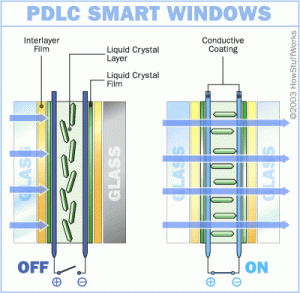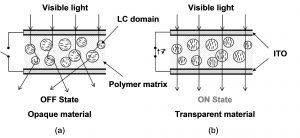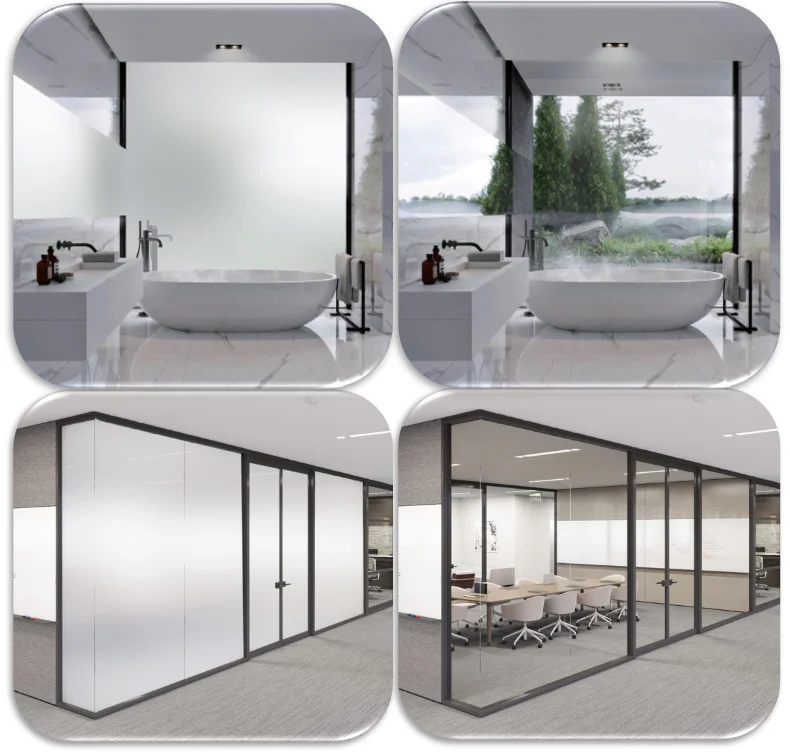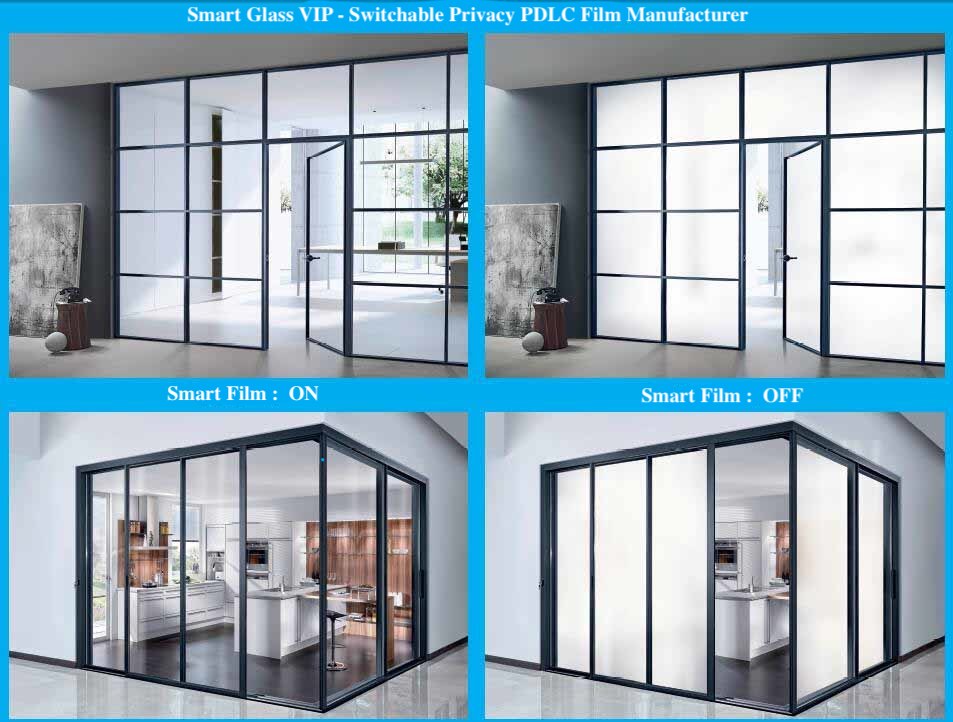How does the smart glass work?
It is manufactured by making use of the PDLC (Polymer Dispersed Liquid Crystal) technology in which liquid crystal micro-droplets are suspended into a polymer base. The natural state of the film is such that the liquid crystals are arranged in a straight line blocking the passage of light through the film – the glass appears to be opaque. We will further elaborate on How does the smart glass work.
Beautiful Houses
Most of us would admit that there is nothing as beautiful as the glass-walled house. However, glass is considered a little less safe and a little less private than the concrete walls in homes, offices, and even in hospitals where you always need opacity.
It seems that things are changing now. Smart glass technology is a revolutionary technology that allows a change in the glass state with just one click. What more is that the glass is 3 times tougher than just the ordinary glass.
When you hear “glass interior” you inevitably think of doors with plain glass that will hinder your privacy. Well, with the growth in modern technology, privacy is one of the most important components of smart glass. This may surprise many but yes, glass doors are something that promises a high level of privacy while maintaining esthetic beauty.
Have you ever wondered how this magic works?

HOW DOES THE SMART GLASS WORK:
Though there are different types of smart glass their basic principle is:
The smart glass is manufactured from the two pieces of the two PET layers. These layers are poly-conductive. If you separate these two layers you can actually see liquid crystals and that’s where the magic happens. Liquid crystal is not actually liquid they are like a spray paint that’s applied in a very consistent manner on the two conductive layers.
- When the smart glass is turned on, particles align, creating transparency for an open atmosphere and natural light.
- When the smart glass is turned off, particles are scattered creating opacity for privacy, shading, or projection.
How does the smart glass work: The science behind it!
High-performance smart glass that is highly advanced, ready to elevate your space provides you privacy, block UV rays, and also providing a projection screen.
Want to know the science behind it?
Your smart glass is the same as that wall-mounted LCD both work on the same principle. There are many types of smart glass. You can classify smart glass into three types: electrochromic, suspended particle, polymer dispersed liquid crystal (PDLC), and nano-crystal. Each of the smart glass types works on different mechanisms.
But today let us discuss the working of most common type:
HOW DOES SMART GLASS WORK: PDLC SMART GLASS
TECHNOLOGY:
In recent years, smart glass has taken the architectural, interior, and product design industries by storm.
Imagine a piece of glass is clear as a crystal, just like ordinary glass. However, once you pull the switch, the glass goes from clear to opaque just in few seconds. Likewise, with another touch, you will see it goes back and forth, back and forth.
The change of state is taking place because of the polymer dispersed liquid crystals. This smart film is made up of plastic polymer with really tiny holes that are about 3 to 0.3 microns. A micron is about one-millionth of a meter these tiny holes are filled with liquid crystals. You can think of it, as a sort of swiss cheese and it is sandwiched between two conductive layers.
So, when there is no current running through them the liquid crystals are randomly oriented inside the holes of the polymer dispersed liquid glass crystal film layer that is applied on your glass doors and windows.
These liquid crystal scatter light as it passes through thus making it look opaque. However, when the occurrence runs through it all the liquid crystals align in the same direction and this allows light to pass.
As the name sort of implies ‘liquid crystal’ has some properties of the crystal and have some properties of the liquid. They are fluid and have the ability to move and make droplets like liquid wood, but they have some properties of crystal-like being able to arrange in a certain orientation.
These liquid crystals are anisotropic meaning that their properties change with their orientation and this is another thing that makes it more like a crystal.
Light Refraction
One of the most important properties to keep in mind while summarizing how does the smart glass work is the refraction or how fast does the light travel through the glass.
You can see what refraction does if you put a pencil in a glass of water. We know that the light travels faster in the air than it does through water and the pencil looks bent or distorted, the same thing is happening with the liquid crystal. When the liquid crystal is in a random orientation, its index of refraction does not match the polymer and this causes it to bend light. Since all the molecules have different random orientations this causes the light to bend and scatter it in all directions.
Making your smart glass opaque, however, when the liquid crystals are lined up with the electric current their index of refraction in that orientation matches the polymer causing the light to go straight and be uninterrupted.
In addition to these liquid crystals having to be made with the matching of indexes of refraction to the polymer. They also have to be rigid enough to align in one direction but still fluid enough to move around.
If you try to use a solace to do this the intermolecular bonds holding molecules together would be too strong and they would not be able to align with an electrical field. In case, you try to do this with liquid, the intermolecular bond would be too weak and their kinetic energy would be too high to align.
Things the Technology offers
These carefully engineered smart glasses have a lot of real-life uses, the biggest use is for privacy. As you can imagine you have a big glass office but then if you want to have a private meeting, you just have to click a button, you don’t have to worry about anybody sneaking in.
In addition to that Boeing has also added smart glass to their 787 dream liner airplanes to replace typical sun shade with the smart glass that allows the level of light and not just have it either open or closed. The technology makes available a dynamic space that can be both private and open.
Conclusion:
Now you know the science behind it, the working of smart glass is very environment – friendly without polluting the surrounding. It runs on the voltage of 60 volts to 110 volts.
A lower electric charge would only result in a few liquid crystals aligning into a straight line, and a higher electric charge would result in an increasing number of liquid crystals forming symmetric patterns.
This is how you can control the opacity or transparency of the smart glass by adjusting the amount of electric charge running through it. Everything at your command!
It is manufactured by making use of the PDLC (Polymer Dispersed Liquid Crystal) technology. In the technology liquid crystal micro-droplets are suspended into a polymer base. The natural state of the film is such that the liquid crystals are arranged in a straight line blocking the passage of light through the film – the glass appears to be opaque.
For More information, Contact us Today.




